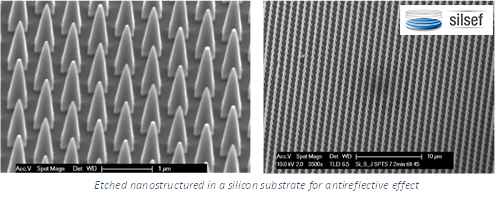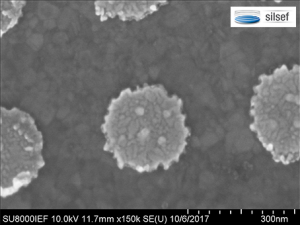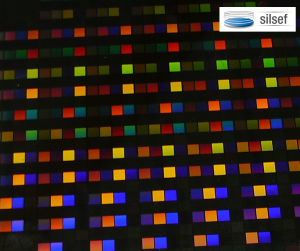Optics
SILSEF nanopatterning technologies are well suited for use in the optics domain. Indeed, micro-nano structures can be used for various application such as diffraction grating for spectrometers, antireflection surfaces, plasmonic effects for bio detection, or light management. Our catalogue of patterns is readily available demonstrations of principle and further developments can be implanted for custurmized applications.
Antireflective treatment
At SILSEF, we realize antireflective treatments by transferring nanostructures into a substrate or a thin film deposited on its surface. Those structures mimick the “moth-eye effect” and act as an adaptative index layer which simulate a low optic index at the tip of the nanostructures and gradually increases to match the index of the substrate.

This technology allows an effective anti-reflexion treatment on a wide spectral band and a large range of incident light angles. It can be applied on large surface, plane or curved and on a wide range of materials.

Plasmonic
Two kind of plasmonic effects can be distinguished : LPR
In unlocalized plasmonic based effects, such as Surface Plasmon Resonance (SPR) type used for sensing, the resonance is due to coupling between the incident light and a metallic periodically nanopatterned surface. It produces a broad absorption dip in the reflection spectrum at the resonance wavelength or at the coupling angle. Such responses can be exploited in sensors for species detection (gas, molecules…)
In localized plasmonic, the electromagnetic field of the incident light is locally enhanced and can thus be used to increase optical coupling (such as SERS based sensors).


Diffraction
A diffraction grating is an optical element having the ability to diffract light by a periodic variation of its profile and / or its index (hologram). Diffraction gratings have the property of deflecting angularly a monochromatic beam as well as angularly separating the wavelengths of a polychromatic beam.
Diffraction gratings have interesting properties in order to “manipulate” light. It is possible to separate a monochromatic incident beam into several beams or to angularly separate the different wavelengths of a polychromatic source. It is also possible to play on different grating’s parameters such as the period, the material, the depth to obtain the desired diffraction intensity .

Light extraction
In nuclear detector, the high refractive index of the scintillator crystals causes a large number of the produced UV-vis photons to remain trapped inside the crystal : therefore up to the 70% of the light produced is not collected by the photodetector. Also, the spatial resolution and the sensitivity of existing systems suffer from this low photons collection efficiency.
SILSEF developed solutions with CERN :
- Light extracting layers can be deposited/fabricated on the exit surface of the scintillator crystal in order to increase the number of photons extracted.
- A possible light extraction layer is a nano-patterned thin film of a material with refractive index higher than the scintillator (n > 1,8) for LYSO : this diffraction grating is referred to as ‘photonic crystal’ (PhC).